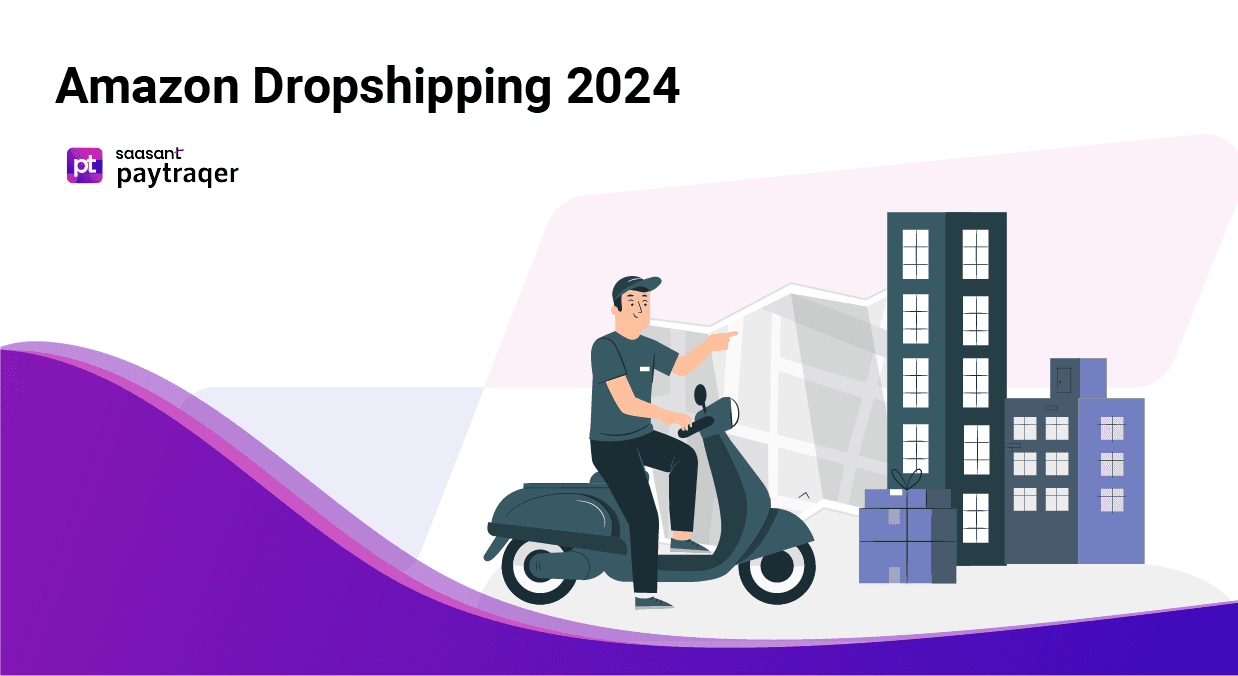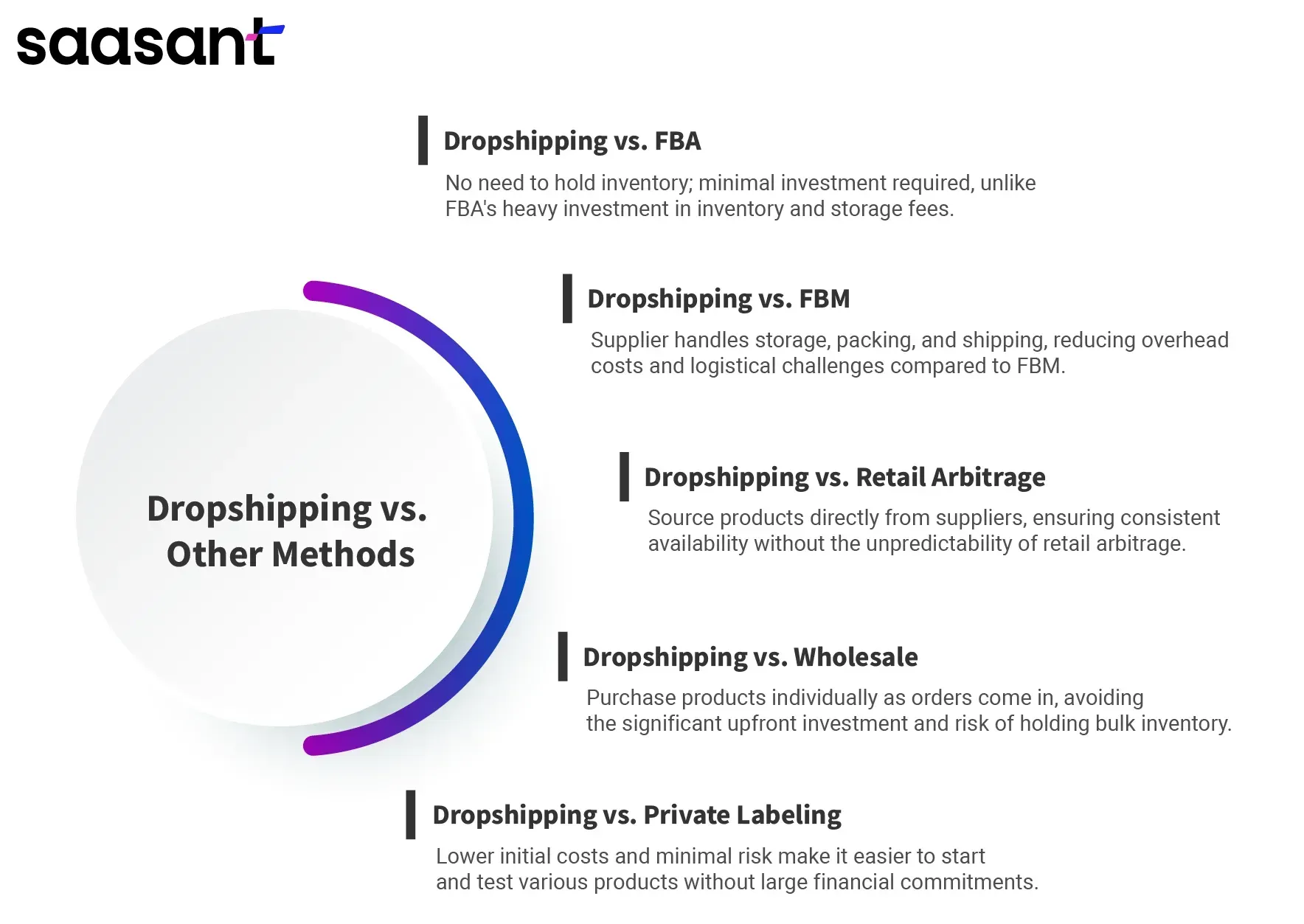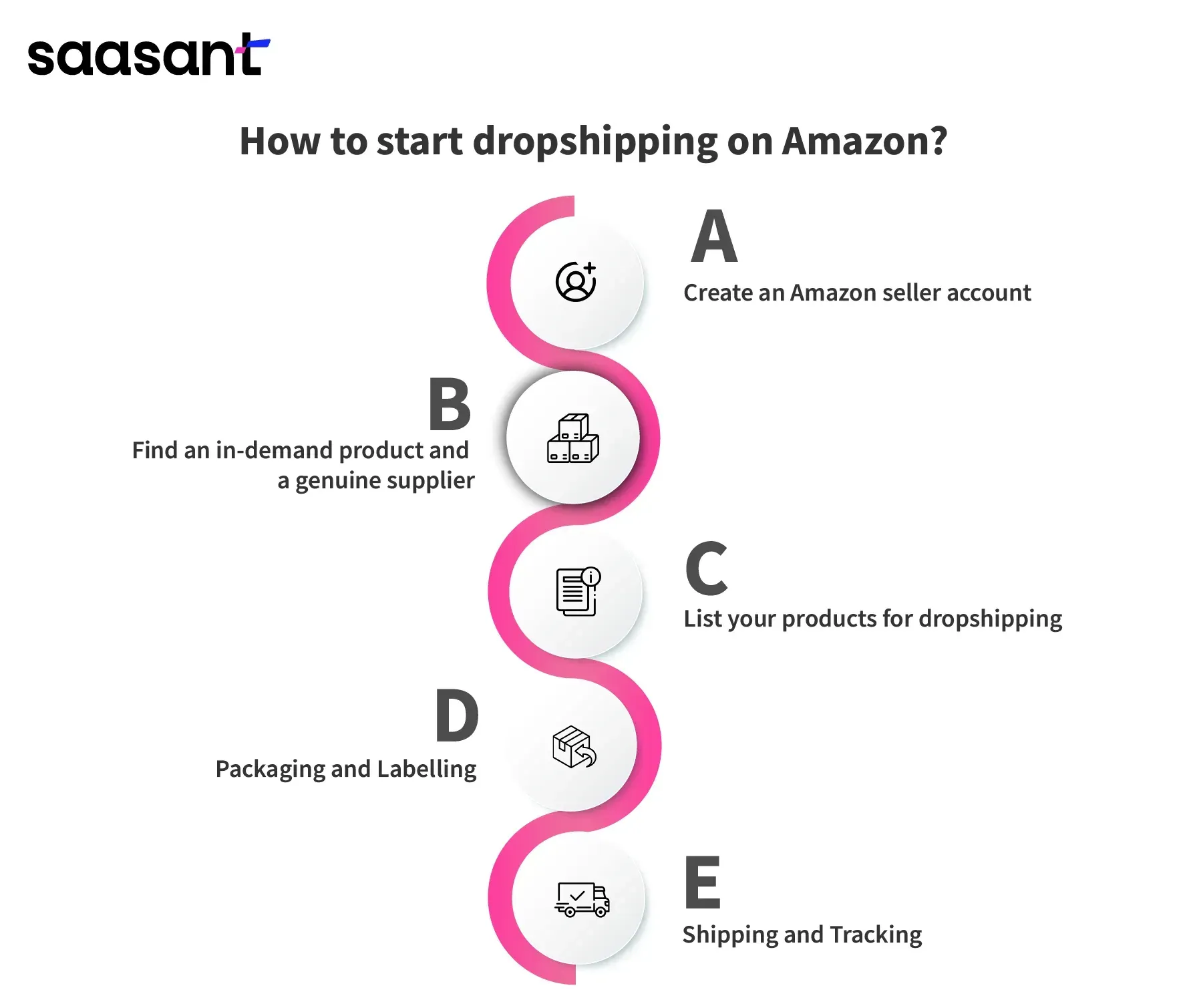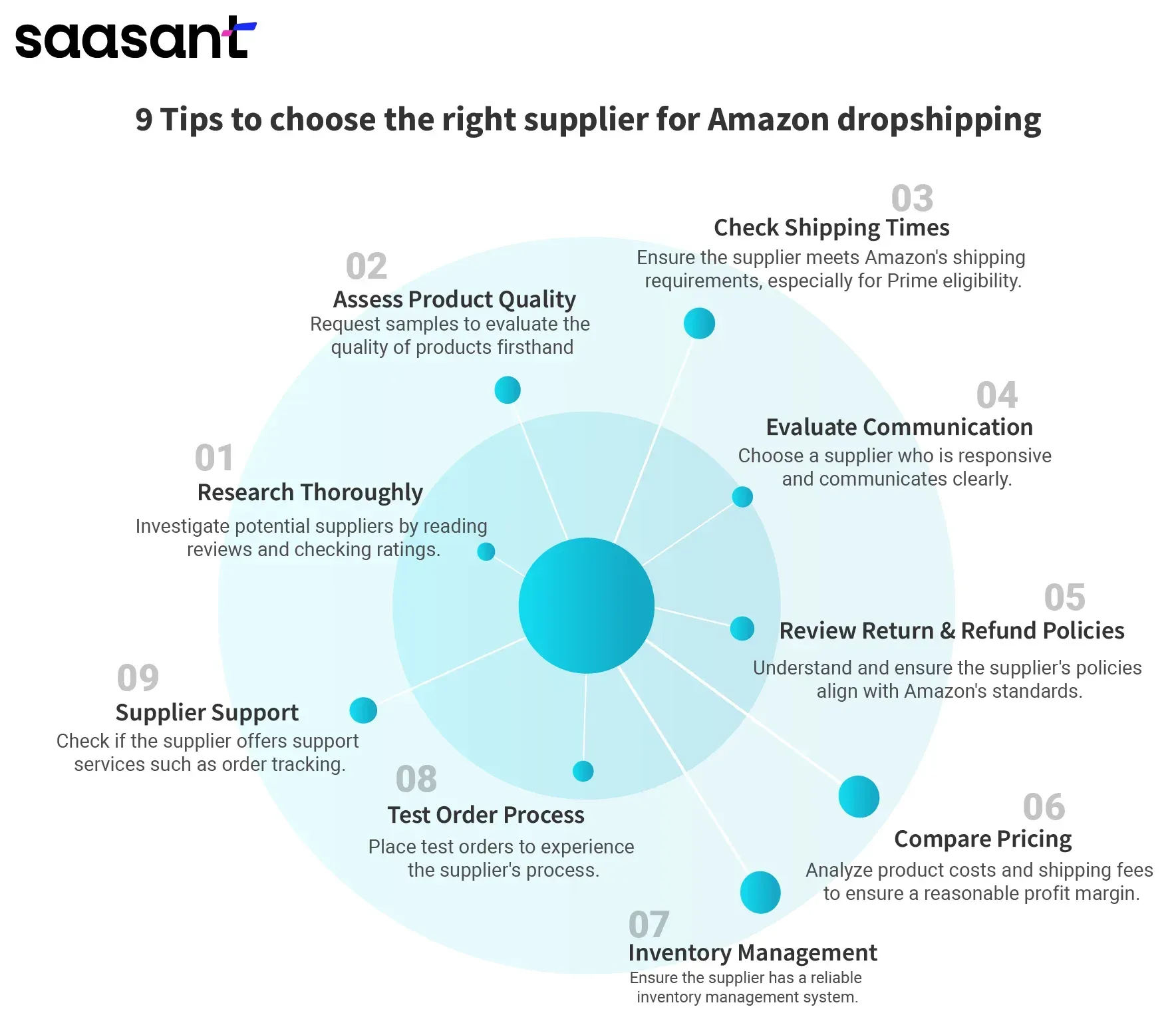Amazon Dropshipping: Strategies for Success and Profitable E-Commerce

Imagine a business model that opens the doors to millions of potential customers while you sit back and make a profit. That's the power of Amazon's dropshipping business model. This fulfillment method allows you to sell products without holding inventory, using Amazon's vast marketplace and fulfillment network.
From 22% to 33%, many online retailers turn to Amazon dropshipping to boost their income. Moreover, 84% of successful online sellers emphasize the importance of building solid relationships with dropship suppliers to thrive in this business model (dropship.io)
From finding the right products to choosing reliable suppliers, this guide will walk you through the essentials of starting your own Amazon dropshipping business, helping you navigate the complexities and capitalize on this lucrative opportunity.
Contents
What is Amazon Dropshipping?
Pros and Cons of Amazon Dropshipping
Is Amazon Dropshipping Legal?
Is Amazon Dropshipping Profitable?
Amazon Dropshipping vs. Other Methods
Amazon Dropshipping Fees
How to Start Dropshipping on Amazon?
Nine Tips to Choose the Right Supplier for Amazon Dropshipping
What Is Amazon Dropshipping Automation?
Start Amazon Dropshipping Today
FAQs
What is Amazon Dropshipping?
Amazon dropshipping is a business model in which you sell products on Amazon without owning or keeping inventory. More precisely, it is an eCommerce fulfillment method where, when a customer orders a product from your Amazon store, you purchase it from a third-party supplier who directly ships it to your customer.
As a dropshipper, you basically act as a middleman who lists products for sale, manages customer service, and handles returns while the supplier takes care of storage and shipping. This allows you to run an online store with minimal upfront investment and no need for warehousing, making it a popular option for new entrepreneurs.
Pros and Cons of Amazon Dropshipping
There’s no doubt that dropshipping has plenty of benefits, but there are also a few cons. Let's examine the pros and cons before considering how to start dropshipping on Amazon.
Pros of Amazon Dropshipping
Low startup costs: There is no need for inventory or warehousing. You only purchase products when you make a sale.
Wide Product Selection: Many products can be accessed without purchasing them upfront. This allows you to quickly adapt to market trends and offer new products without financial commitment.
Scalability: It is easy to scale your business since you don't have to manage stock. Your workload doesn't increase as sales grow, allowing for smoother expansion.
Flexibility: Ability to run your business from anywhere with an internet connection. It offers the freedom to manage your Amazon store remotely, making it ideal for digital nomads or those seeking a flexible lifestyle.
Cons of Amazon Dropshipping
Profit depends on product selection: Since you're buying from a supplier at a retail price, your profit margins can be thin. But look at it this way: low startup costs and lack of inventory management balance out the lower margins, allowing you to reinvest savings into marketing and growth.
Inventory and Shipping Issues: Dependence on suppliers for inventory and shipping can lead to stock shortages and delays. You can tackle this by choosing reliable suppliers and diversifying your supplier base.
Lack of Control Over Branding: You cannot brand your products or packaging. But let’s say your sales grow gradually, and you’ve become a successful drop shipper; then, you can move to private labeling or other models to establish more vital branding.
Customer Service Challenges: Handling returns, complaints, and shipping issues can be more complex. In this case, automation tools and good supplier relationships can make customer service more accessible, and minimal initial investment makes it easier to handle these challenges than traditional retail.
Is Amazon Dropshipping Legal?
Yes, Amazon dropshipping is legal, and Amazon allows dropshipping as long as you follow dropshipping policies. Here are the dos and don’ts you need to know.
1. Be the seller of record: You must identify yourself as the seller on your listings, packing slips, and invoices.
2. Responsible for returns and refunds: You must handle customer service and returns for your products.
3. No purchase from other retailers: You cannot purchase products from another retailer and have that retailer ship directly to your customers.
Following these Amazon dropshipping policies to avoid account suspension and to ensure a legitimate dropshipping business on Amazon.
Is Amazon Dropshipping Profitable?
Yes, Amazon dropshipping can be profitable. But how profitable is dropshipping? Dropshipping stores generate revenue that is 50% higher than stores that manage their own inventory.
Yes, many entrepreneurs have successfully built profitable businesses using this model and Amazon’s vast customer base and infrastructure.
However, several factors must be considered. Here is a list of factors that influence Amazon dropshipping profit.
Product Selection: You must choose the right product with high demand and reasonable competition.
Supplier Reliability: Find reliable suppliers who ensure timely delivery and quality, impacting customer satisfaction and repeat business.
Profit Margins: Dropshipping generally offers lower profit margins than traditional retail. Efficient cost management and volume sales are essential to achieving profitability.
Marketing and SEO: Effective strategies and search engine optimization can drive traffic to your listings and increase sales.
Amazon Dropshipping vs. Other Methods
Let's examine how Amazon dropshipping compares to other e-commerce methods, considering the specific requirements of Amazon's dropshipping policy. We'll delve into the alternatives to dropshipping. This comparison will help you understand why dropshipping can be a smart choice for new and experienced entrepreneurs.

Dropshipping vs. FBA (Fulfillment by Amazon):
Dropshipping offers the advantage of not needing to hold any inventory, making it much more accessible for beginners with limited capital. Unlike Amazon FBA, where you must invest heavily in inventory and storage fees, dropshipping allows you to start with minimal investment and scale without worrying about physical stock.
Dropshipping vs. FBM (Fulfillment by Merchant)
With dropshipping, you don't need to manage storage, packing, or shipping, as these are handled by your dropshipping supplier. In contrast, FBM requires you to handle all these aspects, leading to higher overhead costs and logistical challenges. Dropshipping’s lower overhead costs and ease of scalability make it an attractive model, especially for entrepreneurs looking to grow their businesses without the complexities of inventory management.
Dropshippers vs. Retail Arbitrage
Dropshipping allows you to source products directly from dropshipping suppliers, ensuring a consistent availability of items. Retail arbitrage, on the other hand, involves purchasing discounted products from retail stores, which can be unpredictable and time-consuming. Dropshipping’s consistency and lack of need for physical storage give it an edge, making it a more reliable and efficient business model.
Dropshipping vs. Wholesale
Dropshipping allows you to purchase products individually as orders come in, avoiding the significant upfront investment required for wholesale. This significantly lowers the risk associated with holding bulk inventory. While wholesale may offer higher profit margins, the lower financial risk and minimal investment of dropshipping make it a more accessible and appealing choice for new entrepreneurs.
Dropshipping vs. Private Labeling
While private labeling provides complete control over branding and higher profit margins, it also demands an upfront investment in product development and marketing. With low initial costs and minimal risk, dropshipping is an excellent way to start an e-commerce business. The ease of entry and ability to test various products without significant financial commitments make dropshipping a practical and attractive option for many entrepreneurs.
Dropshipping vs. Etsy
A marketplace focusing on handmade, vintage items and craft supplies requires sellers to manage their inventory and shipping. In contrast, dropshipping sellers offer a wide range of products without creating or stocking them, which is crucial for scaling up quickly.
Dropshipping vs. eBay
Amazon is an auction site that also serves as a marketplace for new and used goods. Sellers manage listings, shipping, and customer service. Amazon’s streamlined fulfillment options and vigorous policy enforcement can provide a more reliable selling environment than eBay.
Dropshipping vs. Shopify
Shopify lets you create your online store with greater control over branding and customer relationships. It's a platform that supports both small and large e-commerce businesses. At Amazon, you benefit from an established, high-traffic platform that can lead to quicker sales cycles and less marketing effort than Shopify.
Amazon Dropshipping Fees
You need to understand the different fees involved in Amazon dropshipping because it's essential to manage costs and profit while adhering to Amazon dropshipping policies. Here are the primary fees you need to consider when running a dropshipping business on Amazon:
Referral Fees
Amazon charges a referral fee for each item sold, which is a percentage of the total sales price, including shipping and other charges. The percentage varies by category, typically 6% to 45%. This fee is automatically deducted from your sales revenue, so factoring it into your pricing strategy is important.
Subscription Fees
To start selling on Amazon, you must choose between an Individual or Professional seller plan. The Individual plan charges $0.99 per item sold, while the Professional plan costs a flat monthly fee of $39.99. The Professional plan is generally more cost-effective if you sell more than 40 items monthly and provide access to additional selling tools and features.
Closing Fees
For specific categories, such as media items (books, DVDs, video games), Amazon charges a closing fee of $1.80 per item. This fee is in addition to the referral fee and is specific to media products. It's essential to consider this extra cost if you plan to sell in these categories.
Fulfillment Fees
You'll incur fulfillment fees if you choose to use Amazon’s fulfillment services for some of your products (known as Fulfillment by Amazon or FBA). These fees cover picking, packing, and shipping your products, as well as customer service and return handling. The fees vary based on the size and weight of the item.
Other Fees
Other incidental fees may apply, such as high-volume listing fees for sellers with many active listings or long-term storage fees if you use FBA and your inventory remains in Amazon's warehouse for an extended period. By keeping track of these potential charges, you can avoid unexpected costs.
How to Start Dropshipping on Amazon?
Now that we’ve seen the pros and cons of dropshipping and other methods compared to dropshipping and fee details, let's jump into the steps on how to dropship on Amazon. Here are five easy steps on how to start dropshipping for free on Amazon.

Step 1: Create an Amazon Seller Account
Start by verifying your email address with OTP and select your account type. Enter business details and credit card details. Name your Amazon store, upload scans of your government ID, and schedule a video call with an Amazon associate to activate your Amazon seller account.
Step 2: Find an In-Demand Product and a Genuine Dropshipping Supplier
Use tools like Google Trends, Amazon Best Sellers, and industry blogs to identify trending products.
Use Amazon’s search bar to find popular keywords related to potential products.
Focus on niche markets where you can offer specialized products that meet specific needs. This can reduce competition and increase your chances of success.
Example: Let's say you notice a growing trend in home fitness, mainly due to more people working out at home. Within this broad category, you could focus on a niche like "yoga accessories for beginners." This niche targets a specific audience interested in starting yoga at home and includes products such as beginner yoga mats, blocks, straps, and instructional DVDs. By targeting this niche, you can cater to a dedicated group of Amazon customers and face less competition than broader fitness categories.
Look for suppliers with prior experience and use platforms like AliExpress, Oberlo, and SaleHoo to find good reviews and reliable shipping times. A rating above 95% is generally considered good.
Step 3: List Your Products for Dropshipping
You can list your products using the Amazon Seller Central app or the website on your PC.
If you use the Amazon Seller Central app, search for the product and click the “sell yours” button. If it is unavailable, click on “Create new listing.”
Provide product details and MRP and select the preferred fulfillment method (FBA or FBM).
Mention if the product has batteries or any safety guidelines if applicable.
The same steps apply to listing your product using your PC, except you have to provide the product's ASIN.
Step 4: Packaging and Labelling
Standard Packaging: Suppliers typically use generic, standard packaging to ensure products are protected and cost-effective.
Protective Measures: Suppliers secure items with bubble wrap, foam, or sturdy boxes to prevent damage during transit.
Shipping Labels: Suppliers generate and attach shipping labels with the customer’s address and other necessary information for accurate delivery.
Amazon Requirements: Ensure suppliers adhere to Amazon's packaging and labeling standards, including correct barcodes and appropriate packaging.
Instructions to Supplier: Provide clear instructions to your suppliers regarding any specific packaging and labeling needs they may have to meet your standards.
Supplier Variability: Work with a consistent set of suppliers to maintain reliable packaging standards and perform regular quality checks to ensure compliance.
Step 5: Shipping and Tracking
Supplier Fulfillment: The supplier picks, packs, and ships the product directly to the Amazon customer, reducing your logistical burdens.
Tracking Information: Suppliers provide a tracking number once the product is shipped, which you must enter into Amazon’s system for customer updates.
Customer Communication: Amazon sends customers shipping confirmation emails with tracking details, ensuring they can monitor their packages.
Shipping Methods: Ensure your supplier’s shipping options align with Amazon’s delivery expectations to avoid delays and potential penalties.
Handling Issues: Work closely with suppliers to efficiently address shipping delays, lost packages, and returns to maintain customer satisfaction and a positive seller rating.
Nine Tips to Choose the Right Supplier for Amazon Dropshipping
Selecting the right supplier for Amazon dropshipping is crucial for your business success. Here are nine tips to help you make an informed choice:

Research Thoroughly: Investigate potential suppliers by reading reviews, checking their ratings, and examining customer feedback for red flags like consistent negative reviews, poor communication, lack of transparency, and unreliable product quality.
Assess Product Quality: Request samples of the products you want to sell to check their quality firsthand.
Check Shipping Times: Ensure the supplier can meet Amazon's shipping requirements and dropshipping policies, especially for Prime-eligible products. Quick and reliable shipping is essential for customer satisfaction.
Evaluate Communication: Choose a supplier who is responsive and communicates clearly. Good communication is critical to resolving any issues that may arise.
Review Return and Refund Policies: Understand the supplier's return and refund policies to ensure they align with Amazon's standards and your customer service expectations.
Compare Pricing: Analyze the cost of products, shipping fees, and any other charges. Make sure the pricing allows for a reasonable profit margin.
Consider Inventory Management: Ensure the supplier has a reliable inventory management system to avoid stockouts and delays.
Test Order Process: Place a few test orders to experience the supplier's process from order to delivery. This will give you insight into their efficiency and reliability.
Evaluate Supplier Support: Check if the supplier offers support services such as order tracking, customer service, and issue resolution. This support can be crucial for maintaining high customer satisfaction.
What Is Amazon Dropshipping Automation?
Amazon dropshipping automation refers to the use of specialized software tools to streamline various aspects of the dropshipping business on Amazon. This includes automating tasks such as product research, inventory management, order fulfillment, listing management, price monitoring, customer service, and financial management. By leveraging automation, sellers can save time and reduce manual efforts, allowing them to focus on growing their business. Tools like SaasAnt Transactions and PayTraQer are invaluable in this process, ensuring seamless integration and efficient handling of financial transactions and data.
Start Amazon Dropshipping Today
In conclusion, Amazon dropshipping offers an excellent chance for new business owners to start selling online with little money upfront. You can sell many products without keeping them in stock by using Amazon's large marketplace and shipping services.
While there are some challenges, like lower profits and relying on suppliers, the advantages of low start-up costs, easy scaling, and flexibility make it a good business choice. Following the steps in this guide and using helpful tools can make your Amazon store run smoothly and increase your chances of success in Amazon dropshipping.
FAQs
Is it worth it to dropship on Amazon?
Yes, dropshipping on Amazon can be profitable, but it requires understanding market demands, sourcing reliable suppliers, and adhering to Amazon's policies.
Is dropshipping on Amazon allowed?
Yes, Amazon allows dropshipping, but you must follow their specific guidelines, including being the seller of record on all invoices and packaging.
How much does it cost to start Amazon dropshipping?
Setting up an Amazon seller account, purchasing inventory, and other initial expenses can cost between $200 and $500.
How profitable is Amazon dropshipping?
Profitability varies, but many sellers see profit margins between 10% and 30% with the right products and efficient operations.
What is the average income from Amazon dropshipping?
Average income varies widely; successful dropshippers can earn anywhere from a few hundred to several thousand dollars monthly, depending on their strategy and product selection.